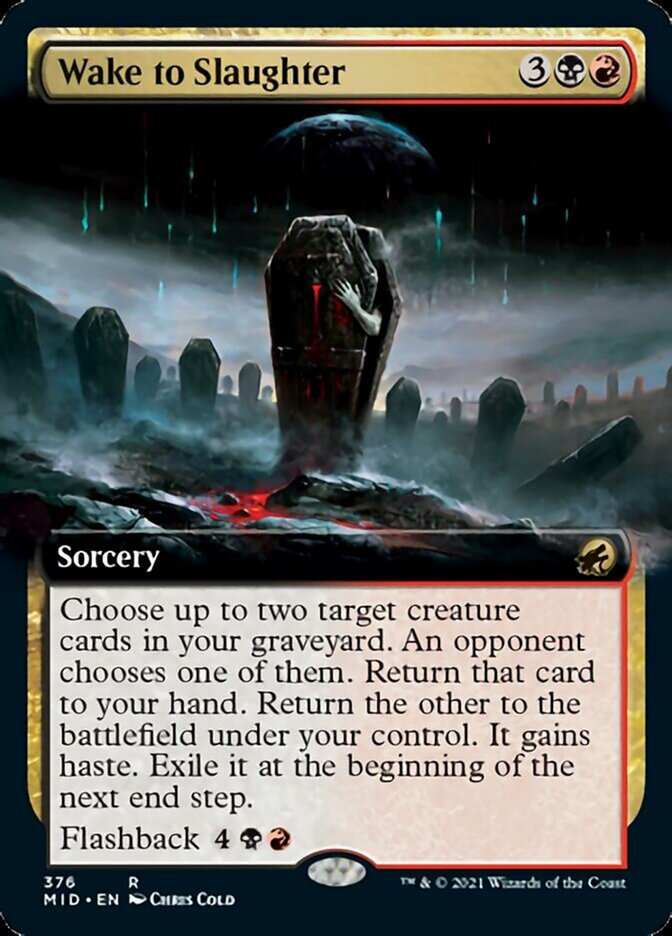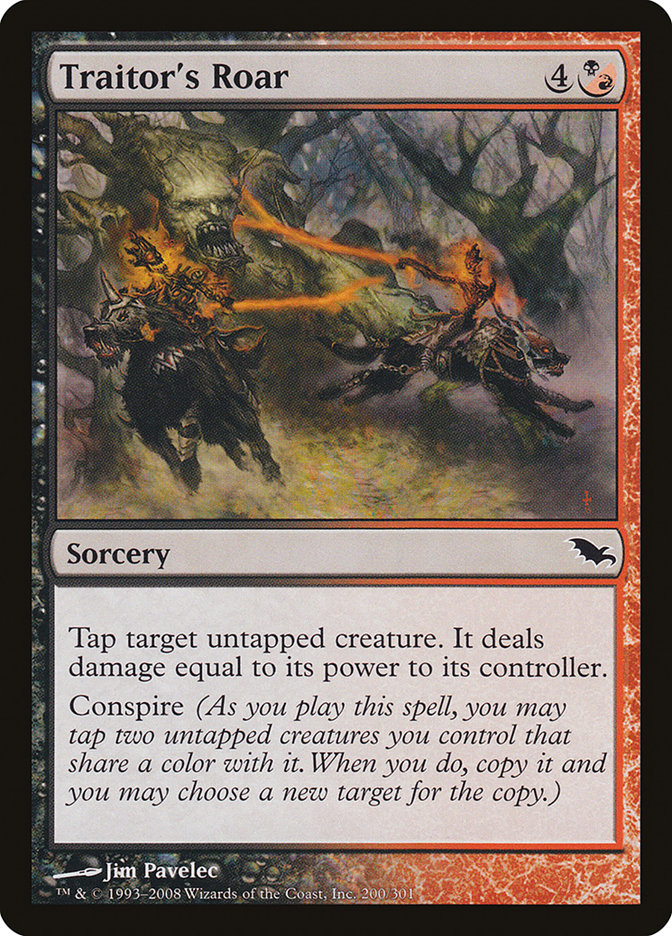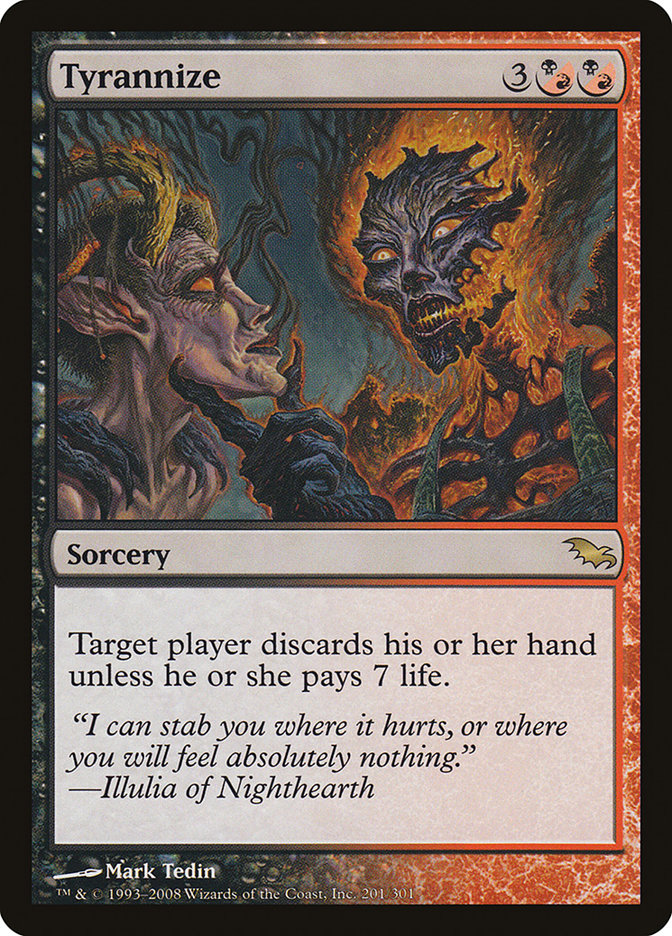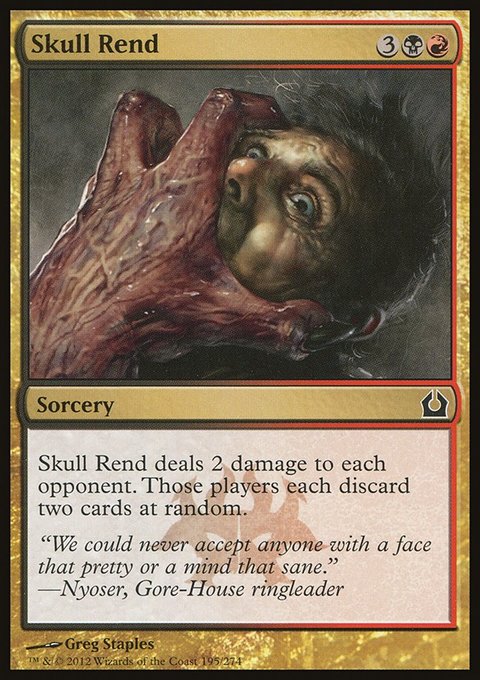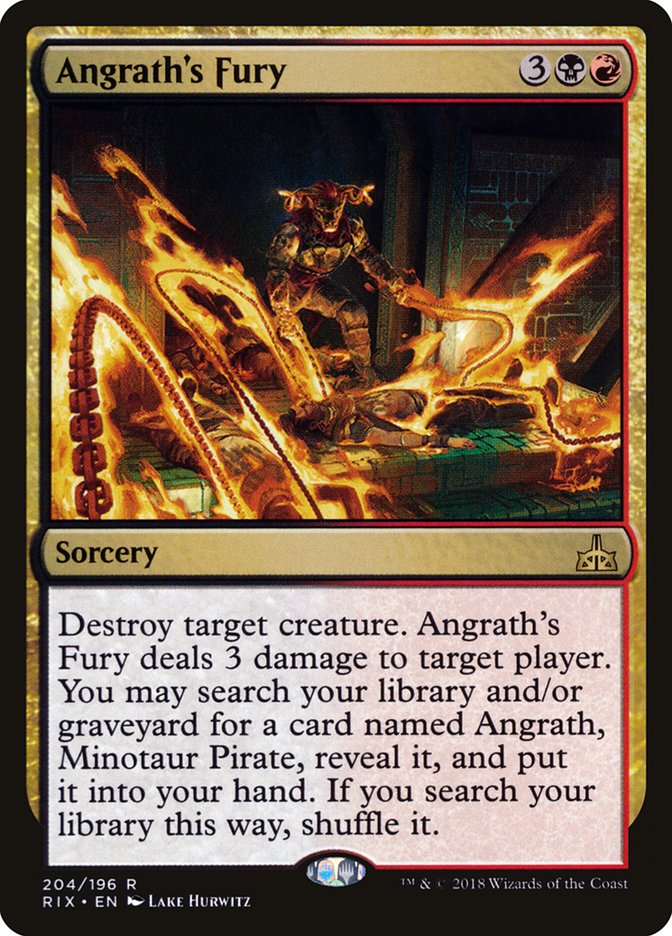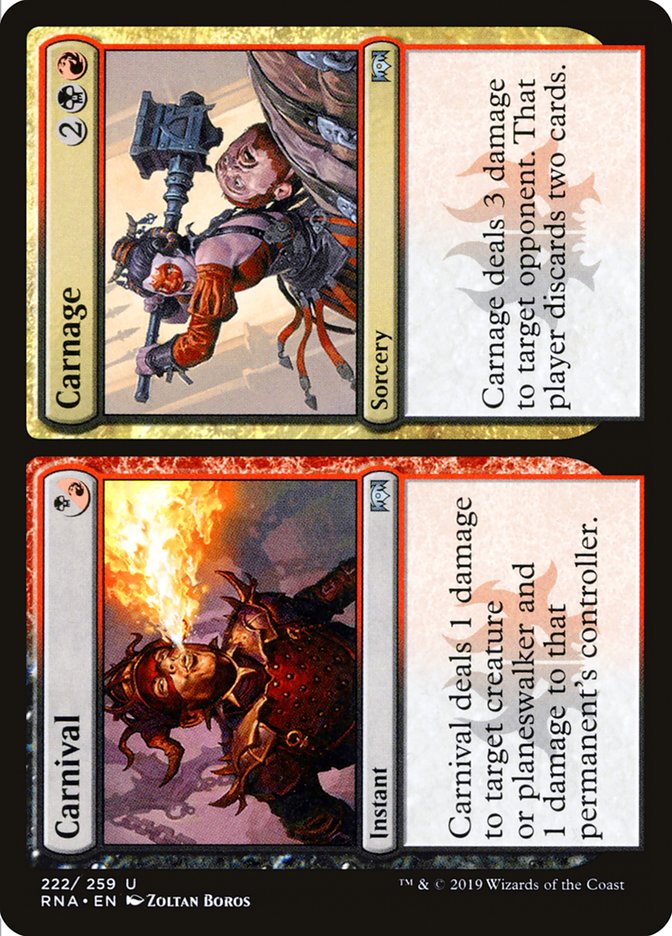Wake to Slaughter MTG Card
| Card sets | Released in 6 setsSee all |
| Mana cost | |
| Converted mana cost | 5 |
| Rarity | Rare |
| Type | Sorcery |
| Abilities | Flashback |
Text of card
Choose up to two target creature cards in your graveyard. An opponent chooses one of them. Return that card to your hand. Return the other to the battlefield under your control. It gains haste. Exile it at the beginning of the next end step. Flashback (You may cast this card from your graveyard for its flashback cost. Then exile it.)
Cards like Wake to Slaughter
Wake to Slaughter is a unique card that finds its place among reanimation spells in Magic the Gathering. It echoes the functions of notorious cards like Zombify, which brings back a creature from the graveyard to the battlefield. Unlike Zombify, Wake to Slaughter offers players a choice to return a creature card from any graveyard, adding a layer of versatility that can be pivotal in games. Moreover, it provides the creature with hastiness, encouraging immediate impact on the game state.
Unearth stands as another comparison point, with its low-cost reanimation ability targeted only to your own graveyard. Although cheaper, Unearth does not provide the same range of choice as Wake to Slaughter. Conversely, Dread Return offers the freedom to choose from any graveyard, much like Wake to Slaughter, but requires a sacrifice of three creatures for its Flashback, making it a more complex play that could either work as a disadvantage or synergize with specific deck themes.
Considering these comparisons with other reanimation cards, Wake to Slaughter presents a compelling option for players seeking to harness graveyard strategies with an added tactical advantage, courtesy of its choice and haste components.
Cards similar to Wake to Slaughter by color, type and mana cost
Card Pros
Card Advantage: Wake to Slaughter bestows the ability to return a creature card from your graveyard straight to the battlefield granting the upper hand in a prolonged game. This form of retrieval bolsters your in-game resources without sacrificing card draws.
Resource Acceleration: What gives Wake to Slaughter an edge is its secondary aspect that allows for another player to choose a card from their graveyard for resurrection. This can lead to potential alliances and shared benefits, propelling both players forward in terms of resources.
Instant Speed: Wake to Slaughter’s instant speed is a pivotal tactical advantage. It offers the flexibility to respond adeptly to your opponent’s moves, disrupting their strategy by reviving key creatures when least expected, thus tipping the scale of the match in your favor.
Card Cons
Discard Requirement: Wake to Slaughter requires the player to discard a card, which could deplete valuable hand resources and potentially put the player at a disadvantage, particularly in games where maintaining card advantage is critical.
Specific Mana Cost: This card demands a precise combination of one Black and one Red mana, which necessitates a dedicated mana base and could restrict deck building options to specific archetypes that can accommodate such costs.
Comparatively High Mana Cost: With a five mana cost (three generic, one Black, one Red), Wake to Slaughter is relatively expensive for its effect, especially when considering the plethora of lower cost alternatives that can reanimate creatures from the graveyard more efficiently.
Reasons to Include Wake to Slaughter in Your Collection
Versatility: Wake to Slaughter offers a dynamic approach to gameplay, allowing players to retrieve creatures from their graveyard with a conditional permanence. It’s suitable for decks that can capitalize on this effect multiple times.
Combo Potential: This card thrives in an environment rich with on-death triggers or sacrifice synergies, making it a powerful piece in any combo-oriented strategy seeking to reuse critical creatures.
Meta-Relevance: In a meta that constantly shifts towards graveyard interaction, Wake to Slaughter provides a means of countering graveyard hate, ensuring your key creatures are always within reach when needed.
How to beat Wake to Slaughter
Wake to Slaughter stands out in Magic: The Gathering for its potential to drive late-game advantage by returning creatures from the graveyard to the battlefield. Key to overcoming this black and red sorcery is interruption and graveyard control. Cards like Tormod’s Crypt provide an effective counter by purging the graveyard, thus denying your opponent the chance to leverage their graveyard as a resource. Similarly, proactive counterspells, such as Negate or Dovin’s Veto, can prevent Wake to Slaughter from resolving in the first place, nipping the threat in the bud.
Another strategic approach involves resource denial, such as land destruction or discard effects to strip this powerful card from your opponent’s hand before they get a chance to cast it. Thoughtseize is a hallmark example, letting you choose and discard a nonland card from your opponent’s hand. By staying one step ahead of your opponent’s plays and managing their graveyard effectively, you can mitigate the impact of Wake to Slaughter on the game’s outcome.
BurnMana Recommendations
Exploring the depths of MTG strategy, especially with cards like Wake to Slaughter, can be incredibly rewarding. This card’s attributes offer not just a means to reclaim fallen creatures, but also create in-game alliances. To harness its full potential, consider the implications of the discard requirement and specific mana needs. If you’re intrigued by the prospect of turning graveyards into arsenals and enjoy manipulating the pace of play, take the next step in your MTG journey. Master the art of resurrection and dominate the board. Dive deeper with us and refine your strategy to raise your game to a notorious victory. Join the community that grows with every shuffle, every draw, every match – let’s advance your MTG prowess together.
Where to buy
If you're looking to purchase Wake to Slaughter MTG card by a specific set like Magic Online Promos and Innistrad: Midnight Hunt, there are several reliable options to consider. One of the primary sources is your local game store, where you can often find booster packs, individual cards, and preconstructed decks from current and some past sets. They often offer the added benefit of a community where you can trade with other players.
For a broader inventory, particularly of older sets, online marketplaces like TCGPlayer, Card Kingdom and Card Market offer extensive selections and allow you to search for cards from specific sets. Larger e-commerce platforms like eBay and Amazon also have listings from various sellers, which can be a good place to look for sealed product and rare finds.
Additionally, Magic’s official site often has a store locator and retailer lists for finding Wizards of the Coast licensed products. Remember to check for authenticity and the condition of the cards when purchasing, especially from individual sellers on larger marketplaces.
Below is a list of some store websites where you can buy the Wake to Slaughter and other MTG cards:
 BUY NOW
BUY NOW BurnMana is an official partner of TCGPlayer
- eBay
- Card Kingdom
- Card Market
- Star City Games
- CoolStuffInc
- MTG Mint Card
- Hareruya
- Troll and Toad
- ABU Games
- Card Hoarder Magic Online
- MTGO Traders Magic Online
See MTG Products
Printings
The Wake to Slaughter Magic the Gathering card was released in 4 different sets between 2021-09-24 and 2022-01-28. Illustrated by Chris Cold.
| # | Released | Name | Code | Symbol | Number | Frame | Layout | Border | Artist |
|---|---|---|---|---|---|---|---|---|---|
| 1 | Magic Online Promos | PRM | 94068 | 2015 | Normal | Black | Chris Cold | ||
| 2 | 2021-09-24 | Innistrad: Midnight Hunt | MID | 376 | 2015 | Normal | Black | Chris Cold | |
| 3 | 2021-09-24 | Innistrad: Midnight Hunt | MID | 250 | 2015 | Normal | Black | Chris Cold | |
| 4 | 2021-09-24 | Innistrad: Midnight Hunt Promos | PMID | 250p | 2015 | Normal | Black | Chris Cold | |
| 5 | 2021-09-24 | Innistrad: Midnight Hunt Promos | PMID | 250s | 2015 | Normal | Black | Chris Cold | |
| 6 | 2022-01-28 | Innistrad: Double Feature | DBL | 250 | 2015 | Normal | Black | Chris Cold |
Legalities
Magic the Gathering formats where Wake to Slaughter has restrictions
| Format | Legality |
|---|---|
| Standard | Legal |
| Historicbrawl | Legal |
| Historic | Legal |
| Legacy | Legal |
| Oathbreaker | Legal |
| Gladiator | Legal |
| Pioneer | Legal |
| Commander | Legal |
| Modern | Legal |
| Future | Legal |
| Vintage | Legal |
| Duel | Legal |
| Explorer | Legal |
| Brawl | Legal |
| Penny | Legal |
| Timeless | Legal |
Rules and information
The reference guide for Magic: The Gathering Wake to Slaughter card rulings provides official rulings, any errata issued, as well as a record of all the functional modifications that have occurred.
| Date | Text |
|---|---|
| 2021-09-24 | "Flashback -ost]" means "You may cast this card from your graveyard by paying -ost] rather than paying its mana cost" and "If the flashback cost was paid, exile this card instead of putting it anywhere else any time it would leave the stack." |
| 2021-09-24 | A spell cast using flashback will always be exiled afterward, whether it resolves, is countered, or leaves the stack in some other way. |
| 2021-09-24 | If a card with flashback is put into your graveyard during your turn, you can cast it if it's legal to do so before any other player can take any actions. |
| 2021-09-24 | If only one target is still legal as Wake to Slaughter resolves (or if you only chose one target), that's the card your opponent will have to choose to put into your hand. They can't choose to have you return it to the battlefield. |
| 2021-09-24 | To determine the total cost of a spell, start with the mana cost or alternative cost (such as a flashback cost) you're paying, add any cost increases, then apply any cost reductions. The mana value of the spell is determined only by its mana cost, no matter what the total cost to cast the spell was. |
| 2021-09-24 | You can cast a spell using flashback even if it was somehow put into your graveyard without having been cast. |
| 2021-09-24 | You must still follow any timing restrictions and permissions, including those based on the card's type. For instance, you can cast a sorcery using flashback only when you could normally cast a sorcery. |
